The concepts covered in this fact sheet go beyond those seen in high school. It is intended as a supplement for those who are curious to learn more.
The great armed pilgrimages organized by the Church during the Middle Ages were known as crusades. The pilgrims and knights of the Crusades took to the road to holy lands, such as the tomb of Christ in Jerusalem.
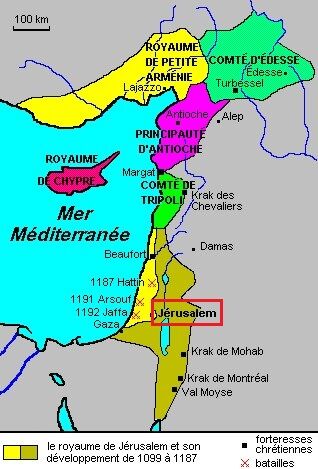
The holy places: pilgrim destinations and crusade issues
Note: Image in English coming soon.
Pilgrimages have taken place since the very beginnings of Christianity. These sacred journeys really began to take hold in the 4th century, after the reign of Emperor Julian the Apostate. These journeys to holy places enabled pilgrims to atone for their sins and free themselves from disease. Whether individual or collective, the many pilgrimages that took place reflected the fascination and veneration of Western Christians for the places where Christ had lived.
Pilgrims set off on foot to the places where Jesus had lived. They traveled without worrying about the length of their journey, or the hardships and difficulties they would encounter. For all these pilgrims, completing such a journey would give them a right of access to paradise.
In 638, the Muslims took control of the city of Jerusalem. This region is an important place of worship for many religions. However, the Muslims in power allowed Christian pilgrims to pass through on their way to the holy sites. In fact, at the time, several monasteries and relays were set up to welcome pilgrims en route and offer them shelter and protection.
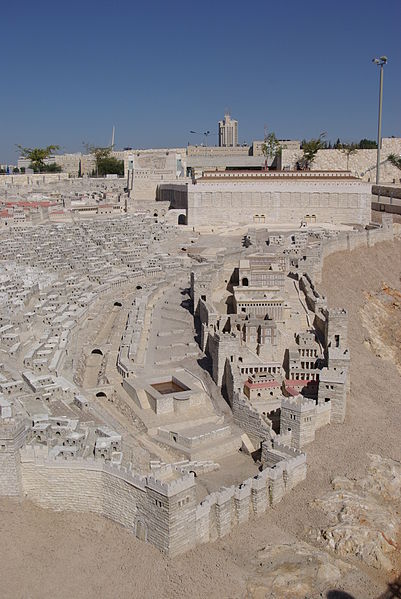
The medieval walls that protected Jerusalem
In 880, Pope John VIII made a declaration that was to have a major impact during the Crusades. He declared that warriors who died fighting pagans would surely have eternal life. This conviction encouraged young knights, nobles and peasants to take up the fight against the pagans with vigor.
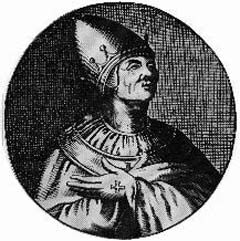
Pope Jean VIII
By 1071, all of Palestine was occupied by the Turks. The Turks posed a growing threat to the territories of the Byzantine Empire, as well as to the western lands. The new rulers of Palestine also prevented pilgrims from entering Jerusalem.
At the same time, the emperor of Byzantium was at odds with the pope and all Western Christians. Although these two groups shared the same religion, Western Christians were trading with non-Christian Eastern peoples.
The emperor of Byzantium, however, felt the Turks' threat hanging over his empire, so he looked to the West for military help in defending his empire. Especially as the Turks continued their conquests in Asia Minor, increasingly threatening to take control of Constantinople.
From 1071 onwards, Western Christians agreed to take up arms against the Muslims of the East, putting an end to the peaceful relations that had united these two peoples. By taking part in the Crusades against the Turks, Western Christians joined forces with Eastern Christians to repel the Turkish threat.
Meanwhile, the Christian Church was growing stronger and more structured. The Church's powerful leaders dreamed of extending their power. These dreams were amplified by recent Western Christian victories, including that which had driven the Muslims from Spain. Buoyed by its recent victories and stimulated by a desire to extend its territory and influence, the Christian Church did not hesitate to launch an offensive in the East and to sanctify wars against infidels (as Jean VIII asserted).
In 1095, several Church representatives gathered in Clermont. At the end of the Council, Pope Urban II issued an appeal to the population to repel the infidels, in particular the Turks.
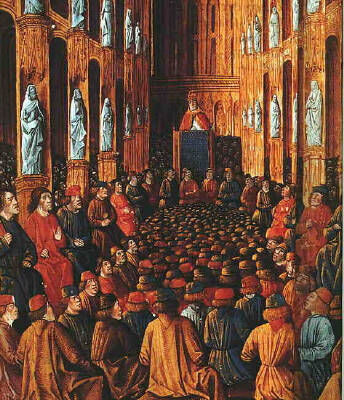
Urban II at the Council of Clermont
More specifically, he encouraged the knights to go and deliver the holy lands and the sepulchre of Christ. To make his point more convincingly, Urban II recalled the Turkish threats to the Byzantine Empire, and expressed his concern at the violence perpetrated against pilgrims in Jerusalem.
In his speech, the Pope encouraged the entire Christian population of the West to support their Christian brothers in Byzantium (Constantinople). Urban II also promised to grant plenary indulgences (remission of all sins) to all those who lost their lives in the fighting. All Christians were thus invited to take up arms in the service of their faith. That's why crusaders (Christian knights who took part in the crusades) wore garments with a cross sewn on.
Although the Pope's speech was an important factor in thousands of Europeans taking up arms to liberate Jerusalem, other factors also contributed to the movement. As the Christian religion spread more and more throughout the Western world, the population was sensitive to arguments linked to the remission of sins, the threat of infidel peoples and personal faith.
In addition, the new feudal organization had increased agricultural production. This had led to an increase in population, and many young knights found themselves without land. The call to crusade gave them the opportunity to travel, experience many adventures and hope to conquer land along the way. These realities had a major impact on the population's enthusiastic response to the Pope's call.
Thousands of peasants were the first to set off for the holy lands. These people were unarmed except for their faith and beliefs. Guided by an apostle and a knight, these peasants were difficult to control on their journeys.
Indeed, they were not aware of the time that had elapsed between Jesus' death and their own lives. For this reason, they imagined that the Jews they met along the way were really Christ's murderers. Indeed, these peasants provoked numerous massacres of Jews and looting during the journey.
On first of August 1096, the pilgrims arrived in Constantinople and were welcomed by the Byzantines. The Byzantines advised them to await the arrival of the knightly crusade before taking any military action. Unfortunately, the unarmed crusaders disobeyed, set off again and were massacred by the Turks. This massacre marked the end and failure of the popular crusade.
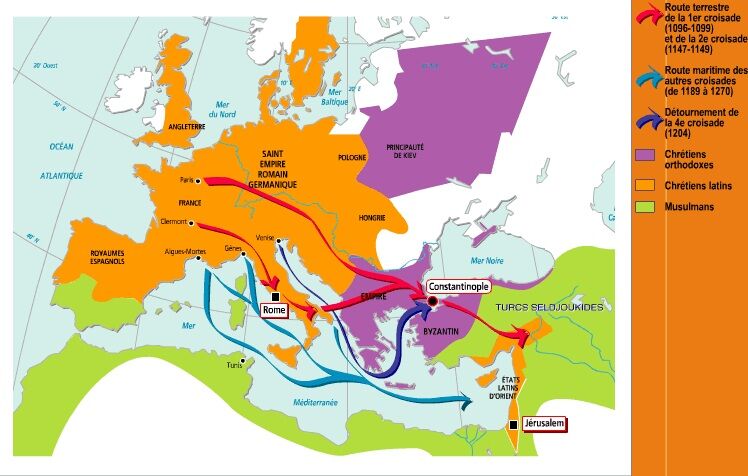
Map of the First Crusade: route and battles
Note : An image in English is coming soon.
In addition to fighting the Turks, the Crusaders had to contend with heat, lack of food, disease and fatigue. In addition, several quarrels arose between the various knights and their leaders. Many of them, forgetting their oath to the Emperor of Byzantium, offered themselves conquered lands, while others considered it more important to continue on the road to Jerusalem, their main objective.
During the journey, the Crusaders took advantage of rivalries between different Muslim groups. When the knights arrived in Jerusalem, the city had already been attacked by the Egyptians and was therefore weakened. After a siege lasting several weeks, the Crusaders succeeded in taking control of Jerusalem in 1099. Their objective had been achieved, despite the fact that they had massacred the city's inhabitants. Of the 150,000 knights who set out on the crusade, only 15,000 made it to the end.
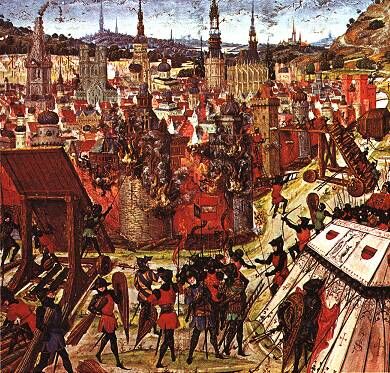
The Crusaders succeed in taking control of Jerusalem
In the years that followed, many knights took the road back home, where they met new knights who would support the crusade. For almost a century, some knights returned home, while others joined the fight for the Holy Places.
The new acquisitions were divided up according to the feudal system. A new culture took root in Palestine, half Latin and half Oriental. To consolidate their conquests, the Crusaders built fortresses.
The Second Crusade was launched to combat the Muslims, who had joined forces against the Franks. This crusade was mainly marked by the loss of several kingdoms conquered during the first crusade.
For the Third Crusade, three powerful rulers joined forces: the King of France, the German Emperor and the King of England (Richard the Lionheart).
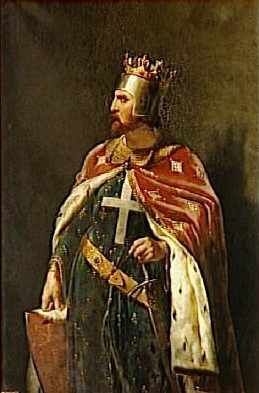
Richard the Lionheart
The knights succeeded in conquering certain territories, but did not fight for control of Jerusalem. King Richard did, however, negotiate certain advantages with the Muslims: a three-year truce for the Franks and freedom of pilgrimage to Jerusalem in exchange for freedom of pilgrimage to Mecca.
Throughout the Crusades, merchants never stopped trading with foreign peoples. These exchanges favored the supply of many commodities. These merchants came from Venice, Genoa, Pisa, Salerno and Palermo. The Italian peninsula enjoyed an advantageous position for sea travel.
After the Third Crusade, not only did trade continue, but the Crusades depended on it. Merchants were not concerned with wars, but only with their own commercial interests.
During the Fourth Crusade, Italian merchants opened numerous trading posts in Egypt. These new trading relationships reduced trade with the Byzantines. This decline in relations with the Byzantines led to the capture of Constantinople by the Crusaders in 1204. This important city remained part of the Latin Empire until 1270.
Launched by Pope Innocent III, this crusade set course for Egypt. The pope was convinced that the conquest of Egypt would facilitate the takeover of Jerusalem. The crusade was a failure.
Entrusted by the Pope to the German Emperor, this crusade was somewhat delayed. In fact, it wasn't until 1228. Using diplomacy rather than fighting, the Emperor nevertheless succeeded in obtaining the return of Jerusalem , as well as the towns of Bethlehem and Nazareth, and a 10-year truce.
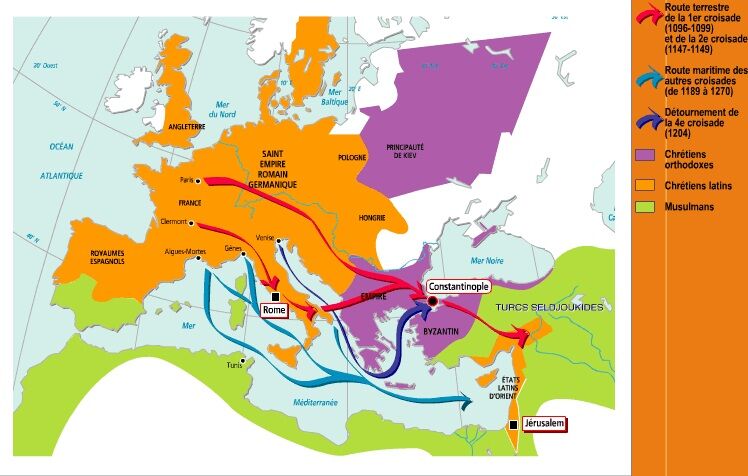
Map of the 6th Crusade
Note: An image in English is coming soon.
By 1244, the Muslims had regained control of Jerusalem , and the West was once again on the crusade to regain possession of it. Organized by French king Louis IX, this crusade once again targeted Egypt. The king wanted to use this territory as a bargaining chip in exchange for the holy lands.
Also led by Louis IX, this crusade did not produce the hoped-for results. Louis IX died of the plague en route, and the Frankish possessions fell in 1290.
At the beginning of the 13th century, many people began to strongly criticize the crusades. They were increasingly skeptical of these armed pilgrimages, which often ended in failure. For many, Christianity and its values had to be defended by convincing people, not by fighting them, and by converting pagans, not by slaughtering them. What's more, the crusades developed in the 13th century were falling farther and farther short of the objectives originally set by Urban II, and costing the Church, lords and knights more and more. These criticisms tarnished the image of the crusades.
The first crusades were really led to help the Christians of the East. This goal was never achieved in practice, and the many attempts to achieve it only served to accentuate the gulf between Latin and Eastern Christians. The growing misunderstanding between these two groups culminated in the definitive split between Greek and Latin Christians.
The first two crusades alone involved some 350,000 people. In total, crusade participants represented between 2% and 3% of the entire adult population of the West. This proportion was even higher for the nobility and bourgeoisie. While the peasants undertook the journey in the name of their faith, the knights went to war to save Byzantium.
The success of the First Crusade is indisputable. The participation of Western knights ensured the survival of the Byzantine Empire and Constantinople, enabling commercial and intellectual exchanges between the two cultures to continue. Had this first crusade not been carried out, it is highly likely that Constantinople would have been definitively taken by the Turks well before 1453.
The Crusades increased resentment of Westerners. Because of the Franks' attitude, Muslims began to distrust Christianity (both Eastern and Western), which only increased Muslim discrimination against Christians.
War rivalries existed between various small groups: Turks, Mongols, Franks, etc., and various religious groups: Shiite Muslims, Sunni Muslims, Ismailites, Eastern Christians, Western Christians, Jews, Armenians and so on. All these groups fought for control of the same territories, but these rivalries could not be considered racism or cultural hatred in the sense we understand it today.
Trade was not greatly affected by the Crusades. What's more, the crusades had no major impact on the economic development of the West. They facilitated the development of the first banks, but they were not the only cause of this development.
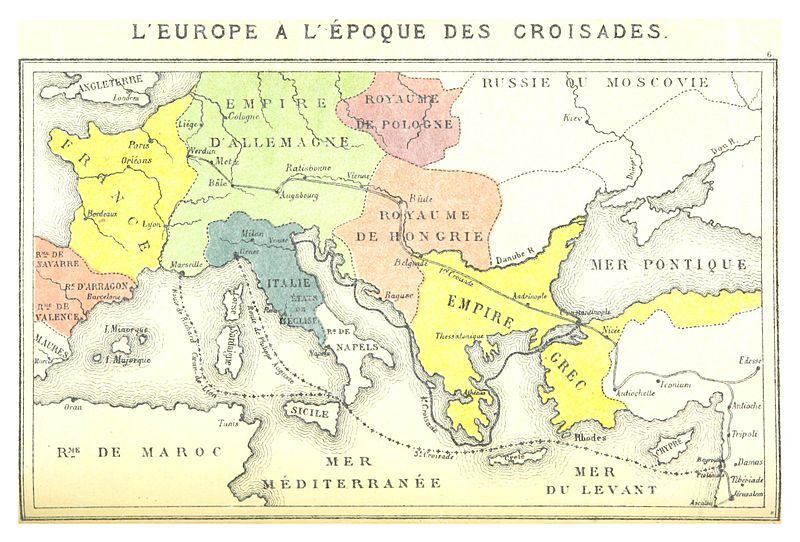
Map of all medieval crusades
Note: An image in English is coming soon.
La forte participation aux croisades a grandement aidé à occuper de jeunes chevaliers qui n’auraient eu ni argent ni terre s’ils n’avaient pas quitté leur lieu d'origine pour ce grand périple armé. De plus, les guerres avec les païens ont permis de mettre fin aux guerres qui avaient lieu entre les seigneuries. Les relations internes devinrent plus pacifiques grâce aux croisades. Cette paix sociale a grandement favorisé l’unité des peuples occidentaux ainsi que le développement économique et social.